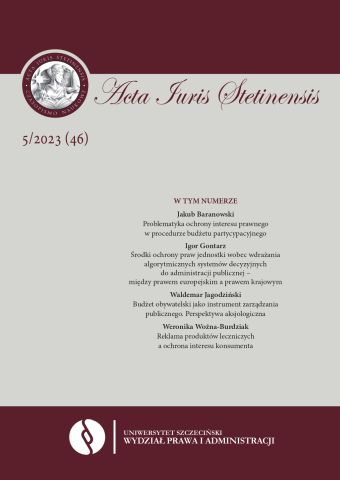






| Authors: |
Paweł
Grobelny

Uniwersytet im. Adama Mickiewicza w Poznaniu |
| Keywords: | landscape resolution advertising resolution spatial order landscape act landscape protection spatial planning and development court-administrative control |
| Page range: | 13 (71-83) |
| Downloads ?: | 42 |
| 1. | Giedych R., Gminna uchwała krajobrazowa – od teorii do praktyki, „Biuletyn KPZK PAN” 2016, nr 261. |
| 2. | Gromek Z., Uchwały reklamowe w orzecznictwie sądów administracyjnych, „Zeszyty Naukowe Sądownictwa Administracyjnego” 2020, nr 1. |
| 3. | Fogel A., Ustawa o planowaniu i zagospodarowaniu przestrzennym – art. 37a, w: G. Goleń, A. Fogel, A. Staniewska (red.), Ustawa krajobrazowa. Komentarz do przepisów wprowadzonych w związku ze wzmocnieniem narzędzi ochrony krajobrazu, Warszawa 2016. |
| 4. | Kledzik P., Skutki uchwalenia uchwały krajobrazowej – w kontekście projektów i unormowań miejscowych planów zagospodarowania przestrzennego, „Acta Iuris Stetinensis” 2019, nr 1 (25). |
| 5. | Mrożewska A., Stańczyk X., Stępień-Dąbrowska A., Pięć lat ustawy krajobrazowej. Raport z monitoringu, 2020, https://issuu.com/miastomojeawnim/docs/piec_lat_ustawy_krajobrazowej_raport_z_monitoringu. |
| 6. | Nawrocki T., Miasta nasze a w nich... Refleksje o wpływie reklamy zewnętrznej na miejską ikonosferę, „Acta Universitatis Lodziensis. Folia Sociologica” 2011, nr 36. |
| 7. | Niewiadomski Z., Komentarz do art. 101, w: R. Hauser, Z. Niewiadomski (red.), Ustawa o samorządzie gminnym. Komentarz, Warszawa 2011. |
| 8. | Niewiadomski Z., w: Planowanie i zagospodarowanie przestrzenne. Komentarz, Z. Niewiadomski (red.), Warszawa 2013. |
| 9. | Nowak M., Gminne uchwały reklamowe – kluczowe problemy, „Nieruchomości” 2018, nr 4. |
| 10. | Parysek J.J., Ład przestrzenny jako kategoria pojęciowa i planistyczna, w: T. Ślęzak, |
| 11. | Z. Zioło (red.), Społeczno-gospodarcze i przyrodnicze aspekty ładu przestrzennego, „Biuletyn PAN KPZK” 2003, z. 205. |
| 12. | Tadych M., Czy uchwały krajobrazowe są zgodne z Konstytucją? – cz. II, „Nieruchomości” 2021, nr 1. |